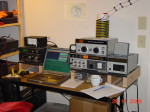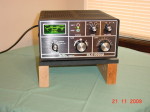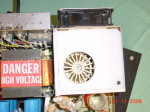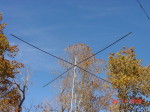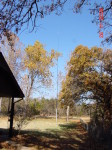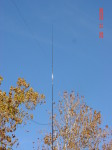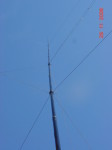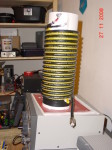My Station: Oklahoma
Oklahoma (2008)
This was my modest contest station.
THE TRANSCEIVER was a TEN-TEC OMNI-VI+ (Opt. 3).
THE LINEAR AMP was a modified Dentron GLA-1000B. The sweep tubes (spark plugs) were replaced with a single GU7B transmitting tube. It ran a nice, clean 600w.
THE MATCHBOX was initially a TEN-TEC Model 238. I eventually replaced it with a Model 238-B which has a turns counter. Electrically they are identical. This is a great matchbox and highly underrated. It is more effecient than most other matchboxes on the market, as documented in ARRL lab tests.
THE ANTENNAS here were based on Spiderbeam hardware. The high bands antenna was initially the Spiderbeam 5-Band "Portable" version covering 20, 17, 15, 12, & 10m. I watched it wiggle and dance in the high, twisty winds of Oklahoma for one year, then I took it down and replaced it with the Spiderbeam 5-Band Heavy Duty version.
The low bands antenna was a vertical dipole, fed with homebrew openwire feedline. It was built on a Spiderbeam 18m telescoping fiberglass pole. The Spiderbeam pole was mounted inside a 10' section of 4" ID thick wall PVC, with the base of the pole raised about 5' off the ground, giving me a total height of about 65'. Each half of the dipole was 9m long. With this antenna, using the Model 238 Matchbox and my "Monster Balun" (see picture), I could obtain a good match on 160, 80, & 40m. It could work the higher bands too, but I had a beam for that.
HOW WELL DID IT WORK?
Well guys, remember, working DX from Oklahoma is not like working from the East Coast of USA; I monitored the DX-Summit cluster and every time a signal popped up on 80m, anywhere in the world, any continent, I worked it first or second call, every time. 40m was a bit tougher. The antenna works great on 40m, but the competition is much harder on that band. Too many people have beams for 40m. I worked everything that showed up on the band, but here it sometimes took 5 or 6 calls to get through the pileup. 160 was troubled with excessively high QRN, so I could hardly hear anything. I didn't gather much experience on that band.
ACCESSORIES: The tiny box to the left of the Schurr Paddle is my home brew CMOS keyer with time-sequencing circuitry for proper timing of the linear amp and CW keying circuits. It is built on the design by Thomas, DL7AV. This was published in the November 1979 issue of CQDL magazine. The watt meter is an old Swan.
I HATE RADIALS. That's why I use a vertical dipole. With a vertical dipole, you do not need a radial network. Unless you make it full size, you do need a matchbox, but as you see, a low cost used Model 238 and a homebrew balun solves that part. You also can use it for multiple bands. When matched with an efficient matchbox, loss due to having a short vertical dipole (on 80m) is less than the loss you have with a traditional full size quarter wave vertical "if" you only use 4 or 8 short ground radials. And it certainly beats the commercial trap verticals!

